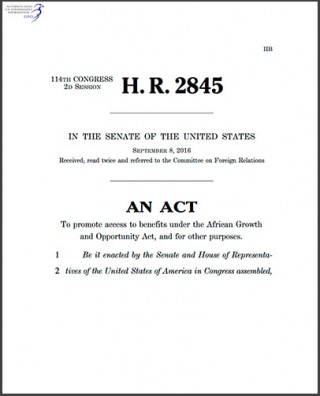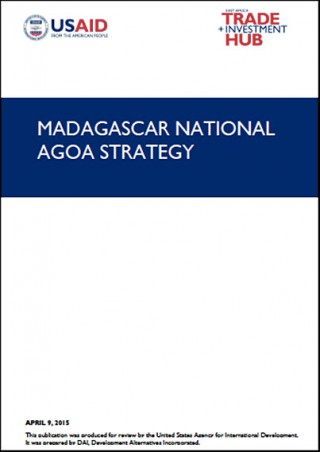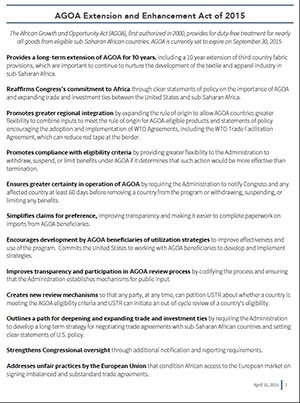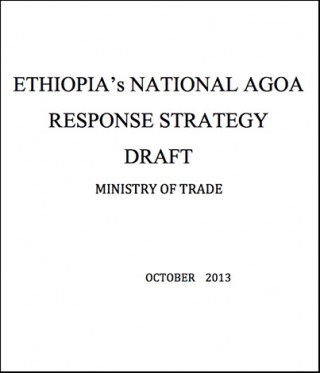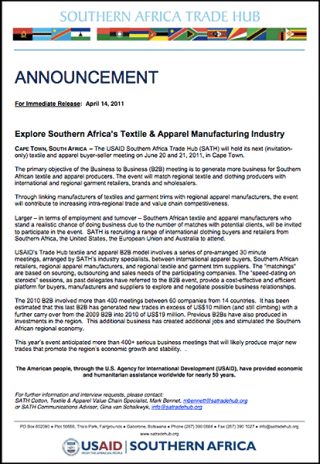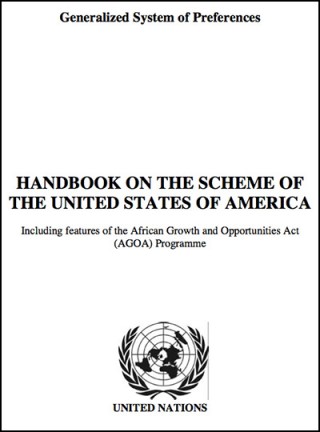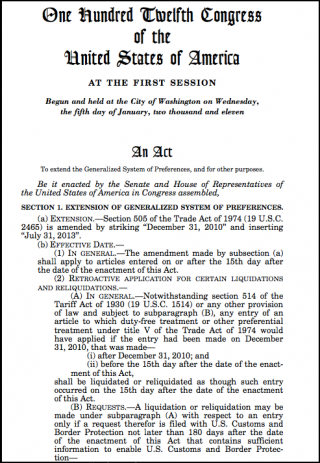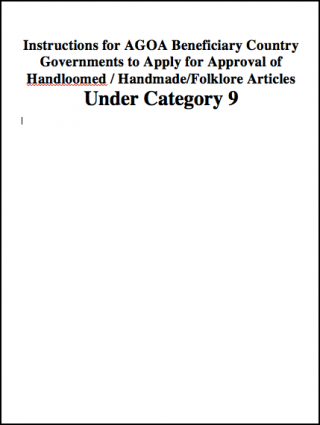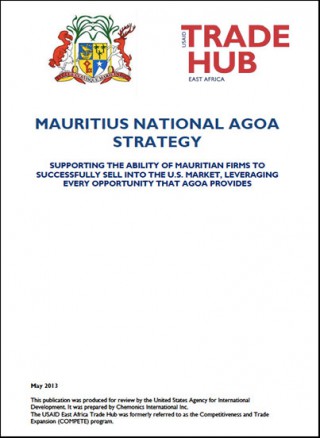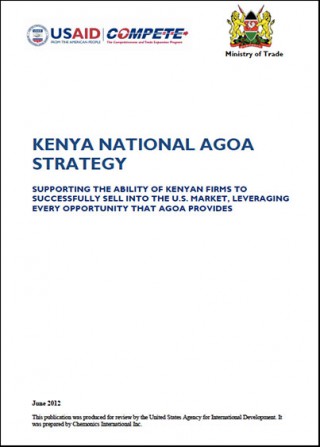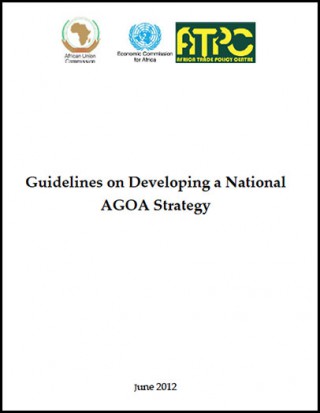General Documents
H. R. 2845 - AGOA Enhancement Act of 2015
An Act, to promote access to benefits under the African Growth and Opportunity Act, and for other purposes. Update: 8 September 2016: Received in the Senate and read twice and referred to the Committee on Foreign Relations. This bill was originally introduced to the House of Representatives on 19 June 2015. On 8 September it was received by the Senate for consideration, and passed on to the Senate Committee on Foreign Relations.
Madagascar - National AGOA Strategy (new version below)
The objective of the AGOA strategy is to support the ability of Madagascar’s firms to successfully sell into the U.S. market, leveraging every opportunity that AGOA provides. AGOA has had a clear impact in stimulating Africa-U.S. trade. All exports, including energy-related products, from AGOA-eligible countries have grown over 300 percent, from $21.5 billion in 2000 to $86.1 billion in 2008. It has created more than 300,000 jobs, many of which are in the apparel sector, an industry that provides employment opportunities for women.
AGOA Extension and Enhancement Act 2015 - Summary
Summary and key points of the AGOA Extension Act 2015.
AGOA: Trade and Investment Performance Overview
This report describes, reviews, and analyzes the trade and investment performance of beneficiary countries under the African Growth and Opportunity Act (AGOA) from 2000 to 2013. It also examines potential products for export to the United States or for integration into regional and global supply chains and examines changes in the business and investment climate in sub-Saharan Africa (SSA), as well as reciprocal trade agreements between SSA and non-SSA partners and the relationship of these agreements to the objectives of AGOA.
Burundi - National AGOA Strategy
The preferential market access granted to Burundi and other African countries through the African Growth and Opportunity Act (AGOA) has yet to benefit to Burundi. In Sub Saharan African AGOA eligible countries, the textiles and apparel sector grew annually at an average rate of five percent since AGOA’s adoption and leading non-textile/apparel exports grew annually at as much as 23 percent between 2001-2006 and an overall rate of 12 percent since 2001. However, preferential access to the US market has not yet contributed to the creation of any significant manufacturing activities in Burundi.
Letter from House Committee on Foreign Affairs - regarding investigation into effectiveness of AGOA
Letter to the U.S. Comptroller General by the US House Foreign Affairs Committee requesting a study to examine the effectiveness of the African Growth and Opportunity Act (AGOA) in an effort to better increase investment, trade and job growth between African countries and the United States.
Ethiopia - National AGOA Strategy (DRAFT)
[Note: an updated strategy is currently being prepared]. The Ethiopian Ministry of Trade, in cooperation with the African Trade Policy Center of the UNECA, has undertaken a grand initiative to develop a National AGOA Response Strategy to identify key supply side constraints that impede the performance of the export sector and suggest possible interventions to help overcome these constraints.
Handbook on the GSP Scheme of the United States 2010 (UNCTAD)
This handbook is a part of a series of publications aimed at helping exporters, producers and government officials to utilize the trade opportunities available under the various GSP schemes.
The US GSP: Background and renewal debate 2013
The expiration of the GSP in July 2013 means that renewal of the program is likely to be a legislative issue in the first session of the 113th Congress. In recent years, renewal of trade preference programs in general, and of the GSP program in particular, has been somewhat controversial. For example, some Members have reportedly asserted that more “advanced” BDCs, such as Brazil and India, should not receive benefits under U.S. preference programs, and propose ending or limiting their benefits in favor of providing a greater share of benefits to eligible least- developed countries (LDCs). Other Members have proposed expanding preferences to grant duty- free, quota-free access (DFQF) to all least-developed countries. This report presents, first, a brief history, economic rationale, and legal background leading to the establishment of the GSP. Second, the report presents a discussion of U.S. implementation of the GSP, along with the present debate surrounding its renewal and legislative developments to date. Third, the report presents an analysis of the U.S. program’s effectiveness and the positions of various stakeholders. Fourth, implications of the expiration of the U.S. program and possible options for Congress are discussed.
Category 9 Textiles - US Customs and Border Protection slides on applicable preferences - 2003
US Customs and Border Protection (CBP) slides on Folklore and Category 9 benefits
SATH Announcement - Textile Buyer-Seller meeting 20 June 2011
Announcement details for the Trade Hub's textiles buyer-seller meeting to be held 21-22 June in Cape Town. The primary objective of the Business to Business (B2B) meeting is to generate more business for Southern African textile and apparel producers. The event will match regional textile and clothing producers with international and regional garment retailers, brands and wholesalers.
GSP Handbook (UNCTAD) 2003
Handbook / Guide on the General System of Preferences (GSP) of the United States. This guide includes features of the African Growth and Opportunity Act (AGOA) as it relates to the GSP. Prepared by the UNCTAD Technical Cooperation Project on Market Access, Trade Laws and Preferences.
US GSP Renewal - October 2011
Legislation passed by the US Congress and signed into law to re-enact the US GSP and restrospectively apply the GSP preferences for 2011 since the former GSP expired in December 2010.
Category 9 Textiles - Guide for eligible governments to the application for traditional fabrics to be included under AGOA
Instructions for beneficiary country governments to apply for approval of handloomed / handmade / folklore articles under Category 9
Guidebook to the US GSP 2006
Guidebook to the US Generalised System of Preferences, on which AGOA is based.
List of GSP-Eligible Countries 2003
This document lists all Sub-Saharan African Countries eligible for benefits under the Generalised System of Preferences (GSP). GSP eligibility does not automatically imply AGOA-eligibility, although it forms the basis on which certain countries were deemed to be AGOA-eligible.
Mauritius - National AGOA Strategy
The preferential market access granted to Mauritius and other African countries through the Africa Growth and Opportunity Act (AGOA) has played a critical role in spurring Mauritius’ exports with the U.S. The textiles and apparel sector grew annually at a steady rate of 5 percent since AGOA’s adoption and leading non-textile/ apparel exports grew annually at as much as 23 percent between 2001 and 2006 and an overall rate of 12 percent since 2001. In effect, AGOA has contributed to expand the apparel industry of Mauritius on a scale that the country would unlikely have achieved without preferential access to the U.S. market.
Kenya - National AGOA Strategy 2012 (updated version below)
The preferential market access granted to Kenya and other African countries through the Africa Growth and Opportunity Act (AGOA) has played a critical role in spurring Kenya’s exports with the US. This has been most dramatic in the case of the textiles and apparel sector, which grew at 44% a year in the few years after AGOA’s passage. In effect, AGOA has created an apparel industry in Kenya on a scale that the country would unlikely have achieved without preferential access to the US market.
Guidelines on developing a national AGOA strategy
This report provides guidelines for developing a National AGOA Response Strategy for African countries that are designated as eligible under the African Growth and Opportunity Act (AGOA). AGOA is a U.S. development effort that was promulgated into law in May 2000 and provides eligible countries in sub‐Saharan Africa with more liberal access to the U.S. market. Initially set to expire in 2008, AGOA was extended to 2015 in 2006, and efforts are currently under way to extend AGOA beyond 2015. ...
AGOA Countries: Challenges and considerations in exporting horticultural products to the United States
Congress, the Administration, and other stakeholders continue to be involved in serious efforts to improve upon the African Growth Opportunity Act (AGOA), which was first signed into law a decade ago, on May 18, 2000. To meet its objective of enhancing U.S. market access for subSaharan African countries that are pursuing market reforms measures, the AGOA preferential trade legislation was designed to encourage and support countries in this region ―that are taking often difficult but critical steps necessary to create more open, market and growth-oriented economies.‖1 AGOA eligibility currently extends to 38 African countries, with some benefitting from exports of natural resources such as oil and minerals, while others have been able to develop textile and apparel industries in which goods are more easily manufactured and exported without barriers to market in the United States. Nigeria and Angola are leading oil producers and suppliers to the U.S.; these two countries alone accounted for 80 percent of all AGOA imports in 2008. In contrast, the value of agricultural exports to the United States from 14 other AGOA-eligible countries was less than $1 million in 2009. In fact, three of these countries – Namibia, Seychelles, and Chad had less than $100,000 in agricultural exports under AGOA in 2009 (see Annex A).


